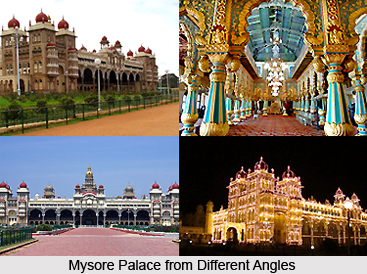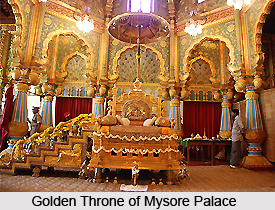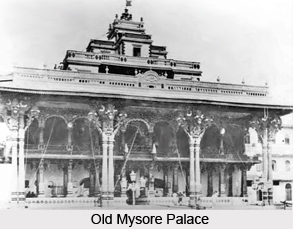About Mysore Palace
 Mysore Palace, once the residence of the Maharajas of Mysore is one of the largest palaces of its kind in India and one of the most splendid. It dominates the skyline of Mysore and it has beautifully designed square towers at cardinal points, covered with domes. It is a three-storied structure, built in Indo-Saracenic style with domes, turrets, arches and colonnades; the palace is a treasure house of exquisite carvings and works of art from all over the world. The tastefully decorated and intricately carved doors open into luxuriously decorated rooms. Henry Irwin, the British consultant architect of Madras state, designed it. The palace was originally built of wood, which got burnt down in 1897 AD and was rebuilt in 1912 AD, by the twenty-fourth Wodeyar Raja.
Mysore Palace, once the residence of the Maharajas of Mysore is one of the largest palaces of its kind in India and one of the most splendid. It dominates the skyline of Mysore and it has beautifully designed square towers at cardinal points, covered with domes. It is a three-storied structure, built in Indo-Saracenic style with domes, turrets, arches and colonnades; the palace is a treasure house of exquisite carvings and works of art from all over the world. The tastefully decorated and intricately carved doors open into luxuriously decorated rooms. Henry Irwin, the British consultant architect of Madras state, designed it. The palace was originally built of wood, which got burnt down in 1897 AD and was rebuilt in 1912 AD, by the twenty-fourth Wodeyar Raja.
Intricately carved doors, the golden howdah (elephant seat), paintings as well as the fabulous, jewel encrusted golden throne (displayed during Dussehra) are amongst the palace`s other treasures. The walled palace complex houses the Residential Museum (incorporating some of the Palace`s living quarters), twelve Hindu temples and shrines including the Shweta Varahaswamy temple, Lakshmiramana Swamy Temple, Someshvara Temple etc. The palace is illuminated on Sundays, Public Holidays as well as during the Dussehra Celebrations when 97,000 electric bulbs are used to illuminate it.
The entry to the palace is through a beautiful gallery featuring Indian and European sculpture and ceremonial objects. Halfway along is the Elephant Gate, which is the main entrance to the centre of the palace. The gate is decorated with floriated designs, and bears the Mysore royal symbol of a double-headed eagle. To the north of the gate the Royal Elephant Throne is displayed which is embellished with 84 kilogram of 24-carat gold.
 The walls of the palace leading to the Kalyan Mandap are lined with intricate oil paintings, illustrating the royal procession of the Mysore Dussehra Festival. Here, the royal throne of the Wodeyars is displayed during the Dussehra festival. A unique thing about these paintings is that seen from any direction, the procession seems to be coming in one`s own direction. The hall itself is magnificent and is decorated with huge chandeliers and multicoloured stain glass arranged in peacock designs. The historic Durbar Hall of the palace has an ornate ceiling and sculpted pillars which are said to have been painted with gold. It has ornate ceiling and sculpted pillars and the Kalyanamantapa (Marriage Pavilion) with its glazed tiled flooring and stained glass, domed ceiling are worth noting. It is also a treasure house of rare paintings by some celebrated artists. This hall, which is up the stairs, offers wonderful view of the Chamundi Hills that towers over the city and houses a temple dedicated to the Goddess Chamundeshwari, the royal family`s patron deity. Gombe Thotti or the Dolls Pavilion, housed in the palace, is a massive gallery that has a huge collection of traditional dolls dating back to 19th and 20th century. It also hosts Indian and European sculptures and ceremonial objects which include a wooden elephant howdah adorned with 84 kilograms of gold. Ambavilasa is another spectacular room which has a magnificent doorway having embellishments of ivory and leads to a shrine of Lord Ganesha.
The walls of the palace leading to the Kalyan Mandap are lined with intricate oil paintings, illustrating the royal procession of the Mysore Dussehra Festival. Here, the royal throne of the Wodeyars is displayed during the Dussehra festival. A unique thing about these paintings is that seen from any direction, the procession seems to be coming in one`s own direction. The hall itself is magnificent and is decorated with huge chandeliers and multicoloured stain glass arranged in peacock designs. The historic Durbar Hall of the palace has an ornate ceiling and sculpted pillars which are said to have been painted with gold. It has ornate ceiling and sculpted pillars and the Kalyanamantapa (Marriage Pavilion) with its glazed tiled flooring and stained glass, domed ceiling are worth noting. It is also a treasure house of rare paintings by some celebrated artists. This hall, which is up the stairs, offers wonderful view of the Chamundi Hills that towers over the city and houses a temple dedicated to the Goddess Chamundeshwari, the royal family`s patron deity. Gombe Thotti or the Dolls Pavilion, housed in the palace, is a massive gallery that has a huge collection of traditional dolls dating back to 19th and 20th century. It also hosts Indian and European sculptures and ceremonial objects which include a wooden elephant howdah adorned with 84 kilograms of gold. Ambavilasa is another spectacular room which has a magnificent doorway having embellishments of ivory and leads to a shrine of Lord Ganesha.
However, the palace has now been converted into a museum, which treasures the souvenirs, paintings, jewellery, royal costumes and other items, which were once possessed by the Woodeyars. It is said that the palace displays the largest collection of gold items, quantity wise. Mysore Palace is enlisted among the most famous and cherished tourist destinations and contributes immensely in the national heritage of India.
Architecture of the Palace of Mysore
 Architecture of Mysore Palace shows the grandeur of mighty Mughal Empire and the art and sculpture of Muslims with the essence of South Indian pigment. Mysore Palace, once the residence of the Maharajas of Mysore is one of the largest palaces of its kind in India and one of the most splendid. The Mysore Palace dominates the skyline of Mysore and it has beautifully designed square towers at cardinal points, covered with domes.
Architecture of Mysore Palace shows the grandeur of mighty Mughal Empire and the art and sculpture of Muslims with the essence of South Indian pigment. Mysore Palace, once the residence of the Maharajas of Mysore is one of the largest palaces of its kind in India and one of the most splendid. The Mysore Palace dominates the skyline of Mysore and it has beautifully designed square towers at cardinal points, covered with domes.
Mysore Palace is a three-storied structure, built in Indo-Saracenic style with domes, turrets, arches and colonnades; the palace is a treasure house of exquisite carvings and works of art from all over the world. The tastefully decorated and intricately carved doors open into luxuriously decorated rooms. Henry Irwin, the British consultant architect of Madras, designed it. Mysore Palace was originally built of wood, which got burnt down in 1897 AD and was rebuilt in 1912 AD, by the twenty-fourth Wodeyar Raja.
The old palace of Mysore was the seat of Power for Krishna Raja Wodeyar the third who ruled from 1799 until 1868. The design and the typical of Hindu architecture of Mysore Palace use a simple column-and-beam structure. The columns however, were elaborately carved in the style commonly found in Mughal or Persian, courts. The ground floor of Mysore Palace an open common space was where the family members could move freely. It`s sometimes referred to as the children`s gallery, perhaps because this is where they could run around and play.
The first floor of Mysore Palace was the Durbar Hall, the grand reception hall, the place where the king would conduct his business of the day, receive guests of state and entertain dignitaries. It was also where major celebrations would occur. The hall of Mysore Palace was 65 square feet and had a raised centre in the ceiling. Apart from the floors which were a mix of plaster and mortar, the entire palace was made from wood.
In 1897, in the Mysore Palace during wedding celebrations of Princess Jayalakshmi Ammani, a fire in the kitchen blazed out of control, and the palace was almost completely destroyed. Only the temple of Atmavilas Ganapthi was left standing, and this was incorporated in the new building. Queen Vanivilasa Sannidhana, who was then the regent, wasted no time in commissioning a new palace to be built on the foundations of the old. No expense was spared in installing whatever was necessary, to make it fireproof, she wanted to ensure that this palace would last, and so it has.



















